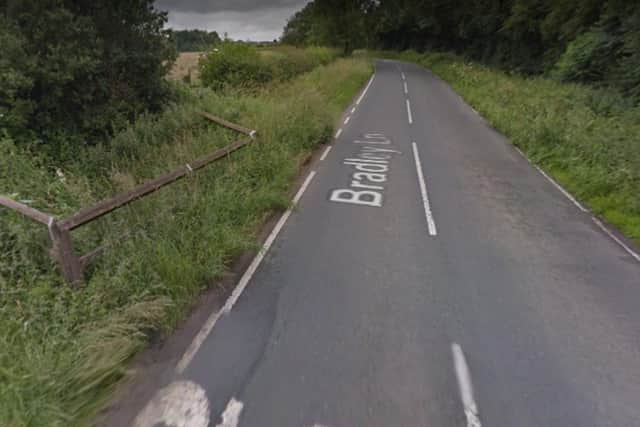Yorkshire mechanic and dad, 28, died when a fence post penetrated his car windscreen on icy road
Paul Alan Chapman, 28, was working with his father Steve at their car repair business on Rufforth Airfield when he decided to check that a VW Passat's handbrake had been fixed properly.
When he did not return to the lock-up, their colleague Gareth Metcalfe went to look for him and found that he had died instantly when a six-metre section of birdsmouth fencing erected around a ditch beside Bradley Lane came loose on impact and penetrated the windscreen, striking his head.
Advertisement
Hide AdAdvertisement
Hide AdMr Chapman, who left partner Emily Pearson and their four-year-old son Lucas, lost consciousness after suffering a major skull fracture.


An inquest at North Yorkshire Coroner's Court today heard that the Chapman family had written to City of York Council with serious concerns over both the gritting of the rural road on the night of January 5, 2021 - when temperatures dropped to below freezing - and the maintenance of the fencing.
Assistant coroner Richard Watson heard evidence from highways engineers at the council about gritting protocol and the appropriateness of the fencing, which was in place around the culvert to protect pedestrians and cyclists from the concealed ditch.
Mr Chapman's mother Deborah described him as a 'perfect partner' to Emily whose son Lucas was 'the apple of his eye'. He had joined his father's business after leaving York High School and was said to be a gifted mechanic who was preparing to take over the garage.
Advertisement
Hide AdAdvertisement
Hide AdThe family said they were 'devastated' by his loss and that his passing had left a 'massive hole in our hearts'.
Both they and Mr Metcalfe presented anecdotal evidence of other accidents involving Bradley Lane in Rufforth and the same fence, but the coroner was told by City of York Council's principal engineer David Mercer that there were no records of other collisions at the same location on a database shared with the police.
It was agreed by all who attended the scene of the crash that the road surface had been damp, icy and extremely treacherous.
The Chapmans questioned whether the lane had been gritted at all before the collision just after 9pm, and the council supplied GPS tracking data proving that a vehicle had driven down Bradley Lane just after 6pm at a speed consistent with salt spreading.
Advertisement
Hide AdAdvertisement
Hide AdExpert witness and forensic highways engineer Mike Hopwood, who prepared a report on the incident for the council, told those present that it was 'unlikely' they would be able to physically see grit salt on a wet surface, as it is designed to dissolve. Mr Metcalfe had claimed that there was none visible when he found Mr Chapman.
Mr Hopwood added that birdsmouth fencing is commonly used at roadsides and that he could not recall any other serious accidents involving it. He added that he believed it was not only appropriate but 'essential' on Bradley Lane to prevent those on foot from falling into the ditch.
He considered it 'highly unlikely' that the gritter's salt spreading function had failed to work, as the vehicles are fitted with alarms and cameras giving the driver a view of the rear, and no leftover salt was recorded when it returned to the depot.
Although he said that in theory there was 'no reason at all' why the road should have been icy after being treated with 20g of salt per metre squared earlier that evening, he conceded that a rain shower recorded by a weather station two miles away could have been heavier than predicted.
Advertisement
Hide AdAdvertisement
Hide AdMr Hopwood said: "It was measured at 2-3mm of rainfall and that isn't enough to wash grit away - you would need twice as much. I am flummoxed as to why the road was so icy. It is possible that it could have been heavier in the accident location. Heavy rain does dilute salt or wash it away.
"It's possible that water did gather in a low spot in the road, and that it was blown towards the bend in both directions. I'm confident that vehicle was spreading, but it would be hard to see the salt. It can only be seen on a dry surface up to 40 minutes after being spread. Bradley Lane was damp and it would have dissolved."
North Yorkshire Police's collision investigation found no defects to the Passat and concluded that Mr Chapman had lost control on a bend. It was noted that under the Highway Code, drivers are advised to travel with care even when roads have been treated for ice, and be aware that conditions can change quickly over short distances.
Recording a conclusion of death in a road traffic collision, Mr Watson said: "I find as fact that the road was gritted generously and that there were no faults with the gritter's operation. I also find that the road was very icy and slippy. It can be speculated that the rain was heavier than that recorded, or that the road was lower at the point in question and water could have accumulated.
Advertisement
Hide AdAdvertisement
Hide Ad"I can draw no definitive conclusions as the circumstances are so unusual. This sort of fencing is used extensively, it had been inspected regularly and was not perceived to be a risk. Councils may now reconsider how appropriate its use is, and I believe City of York are already addressing this question. There are no easy answers given the competing interests of different road users."
